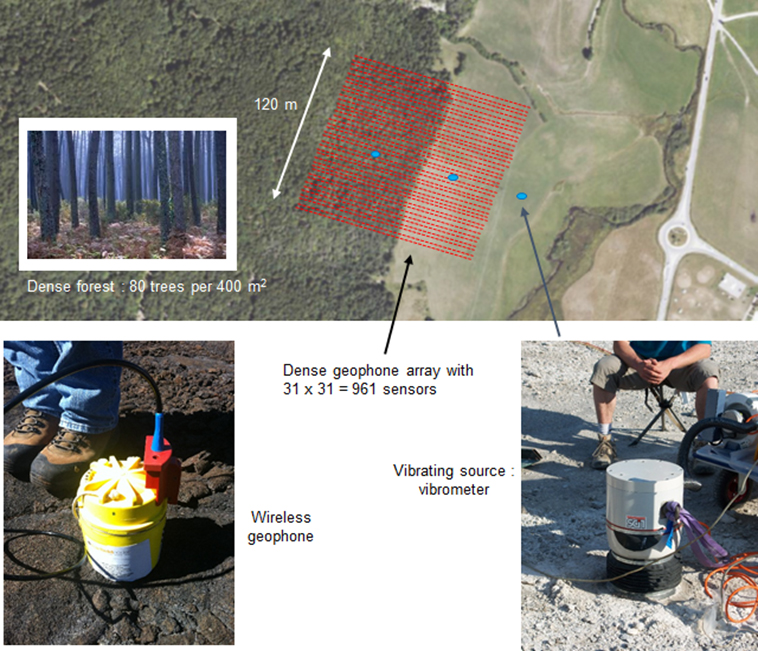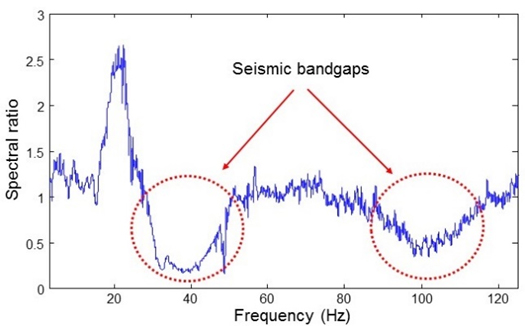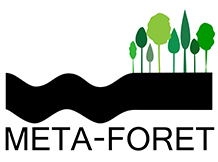1/ The forest experiment | Year 1 of the project
The first aspect of WP1 is the deployment of a very dense array of three-component geophones at the interface between an open field and a forest. To find out the optimal forest configuration, a collaboration was started with R. DE LARY, Head of the “Centre National de la Propriété Forestière d’Aquitaine” (CNPF) which manages the 1 million hectare of pine tree forests in the Landes department. During a visit of P. ROUX to Bordeaux in 2016, different sites were investigated and two possibilities emerged with : (1) a maritime pine tree forest with tree height of 15 m with a density of 800 trees per hectare (unit mass of 0.3 t per tree and one tree every 12.5 m2) and (2) a poplar forest with tree height of 40 m with a density of 200 trees per hectare (unit mass of 1.2 t per tree one tree every 50 m2). The CNPF will contribute to the project with a technician whose tasks will be to (1) manage the administrative authorizations for the seismic array deployment on the selected sites and (2) clean the ground from possible brambles or blackberry bushes in order to facilitate the seismic sensors installation.
The seismic array will be made up of 31 × 31 = 961 sensors in a regular grid with 4-m inter-element spacing, thus covering an area of 120 m × 120 m (Fig. 1). The spacing has been chosen to match as closely as possible the half-wavelength spatial sampling requirement of the seismic field, both in the forest and in the open field. With the expectation of surface-wave velocities between 150 m/s and 300 m/s (depending on the ground composition : sand or clay) in the frequency range [5 Hz to 50 Hz], the choice of 4-m as the inter-element spacing appears to be the optimal compromise.
Note that a similar dense array deployment (involving more than 1,100 sensors over a 500 m × 500 m area) was already performed in June 2014 with the same seismic sensors around the San Jacinto Fault (South California) in a collaborative study between ISTerre and the University of South California. Moreover, ISTerre has gained great experience in this novel type of seismic deployment in July 2014, as can be seen from our recent VOLCARRAY experiment on the slopes of the Piton de la Fournaise Volcano. For these types of dense and short-distance seismic acquisitions, the sensor weight is typically 2.5 kg. These sensors are autonomous (wireless), synchronized with GPS, possibly three components, and can record continuously over a maximum of two weeks (see section "Scientific challenges" Fig. 1). American technology was used on the Piton de la Fournaise Volcano with FairFieldNodal Zland sensors ([see details at http://www.fairfieldnodal.com/seismic-systems/zland-overview). French technology for wireless seismic sensors of the same type has been proposed by Sercel, for an equivalent leasing price to the Unite sensors (see technical details at http://www.sercel.com/products/unite.aspx). Finally, note that this seismic experiment does not require the purchase of any sensors, but only a leasing for a duration to be determined. In our case, the two-week autonomy is sufficient for the purpose of the experiment, and there will be no need for any swap with another set of sensors, as is usually done in seismic exploration experiments in the oil and gas industry for a significant extra-cost. In practice, the installation of 1000 wireless sensors on a one hectare area will required 10 (non-qualified) persons during two days. Travel expenses and missions associated with this field experiment have been added to the budget.
This spatial density of three-component sensors is mandatory to accurately measure the dispersion curves outside and inside the forest, and it also needs to be at the transition between an open field and the forest. We believe that comparisons between the dispersion curves in these different areas will confirm the metamaterial behavior of the forest, and will demonstrate in particular the hybridization effect that is associated with the resonances in the trees. Note that whether periodic or random, the spatial arrangement of the trees is of little importance, as metamaterial physics is not based on the Bragg scattering effect that is classically observed in periodic crystals, but on the collective behavior of resonators that are arranged at a sub-wavelength scale.

Depending on the tree density and the tree height, different bandgaps are expected (see Fig. 2) that also depend on the impedance match between the ground elastic properties and the resonating trees. Numerical simulations will be needed (as part of WP3.2) to anticipate the experimental results at the geophysics scale and help in determining the optimal site configuration in terms of tree height and density and also ground properties. To this end, the META-FORET project will be approved by the “Pôle of Competitiveness XYLOFUTUR : Produits et Matériaux des Forêts Cultivées” who gathers industrial and academic institution around the growing of the Landes forest. In particular, meetings with INRA Bordeaux-Aquitaine scientific colleagues (UMR BIOGECO & UMR ISPA) are planned to discuss the optimal ground property configuration for the tree forest experiment.
Ambient noise recording . In the first step, long intervals of continuous ambient noise will be recorded by the seismic array. A preliminary experiment performed in May 2014 with two seismometers, as one inside and one outside a small-sized forest at the University campus in Grenoble, revealed two potential bandgaps (around 40 Hz and 100 Hz) from 1 h of seismic ambient noise recording (Fig. 1). These encouraging results justify by themselves the present project, with our ambition being to now measure the complete spatio-temporal signature of a forest, as was performed at the laboratory scale with the rods attached to the plate (see section "state of the art" Figs. 2 & 3). As ambient seismic noise is dominated by surface waves, this ambient noise might be a good candidate for working with the waves that are trapped close to the subsurface. In the case of omnidirectional noise sources, the dispersion curve can be obtained from a kx-ky frequency–wavenumber transformation along the two directions of the seismic array. However, this isotropic noise distribution is in practice difficult to obtain at frequencies above 5 Hz, because of the predominance of human-generated seismic noise sources (e.g., cars, industry). This means that long-term recordings might be necessary to reach this condition, and especially day and night recordings. For the extraction of dispersion curves from ambient noise data, the global seismic array will be divided into two sub-arrays, as the open-field array and the forest array. We expect to observe seismic bandgaps inside the forest, using the dispersion curve in the open field as a reference. As well as the bandgaps, the dispersion curves should reveal any typical abnormal behavior due to hybridization close to the resonant frequencies of the trees. If the aims are achieved, the dispersion curves inside the forest should reveal the metamaterial nature of the forest.
Finally, note that the wind might be another source of excitation for the trees, with potential flexural excitation transmitted to the ground. Wave excitation from the ground to the trees or from the trees to the ground might lead to different results, as different types of resonance can be induced in these two cases : compressional resonance, if vertical displacement associated with Rayleigh waves excites the trees ; flexural resonance, which can lead to horizontal ground motion if the wind is the dominant excitation source.

Active shots . In a second step, a vibrometer source (property of ISTerre) will be used as an active source to complement the ambient-noise recordings. The vibrometer is fully programmable and works efficiently between 10 Hz and 500 Hz. With the restriction to frequencies between 10 Hz and 100 Hz, we will generate 1-min-long frequency-modulated sweeps, to obtain a sufficient signal-to-noise ratio for all of the seismic sensors. These active shots will be synchronized with GPS and will be stacked over a large number of repetitive acquisitions. The use of active shots will represent a spatio-temporal wavefield as it penetrates into the forest. Snapshots similar to those obtained at the laboratory scale (see section "State of the art" Fig. 2a&b) will then be reproduced at the geophysics scale. We expect to observe strong damping of the incident field when it is filtered in the frequency bandgaps revealed by the dispersion curves. At the same time, we should also obtain sub-wavelength and supra-wavelength modes as in locally resonant metamaterials (see section "State of the art" Fig. 2c&d). The use of an active source will also provide measurements of the dispersion curves in the frequency band of the excitation, which will be compared to those obtained from the ambient-noise measurements.
When compared to the laboratory experiment performed with rods attached to a plate (see section "State of the art" Fig. 1), the great advantage of the forest configuration is the possibility to move the source inside the array, and especially inside the forest. The excitation of the metamaterial from inside is of foremost importance, to understand the local coupling with the resonators and the emergence of high-frequency wavenumbers within the medium. To date, the theoretical interpretation of such a locally resonant metamaterial was performed through Fano interference between the propagating and scattered waves ; i.e., an approach that neglects near-field effects. The possibility to excite the forest and to record the near-field contribution close to the resonators will shed new light on the interpretation of metamaterial physics.
Updated on 10 octobre 2016


